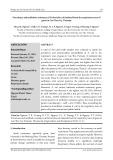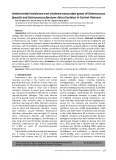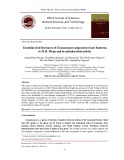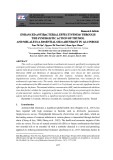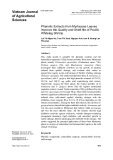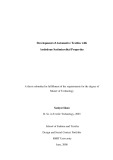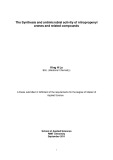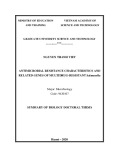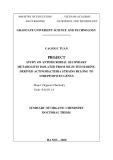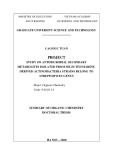doi:10.1046/j.1432-1033.2002.02842.x
Eur. J. Biochem. 269, 1974–1983 (2002) (cid:211) FEBS 2002
Reconstitution of coupled fumarate respiration in liposomes by incorporating the electron transport enzymes isolated from Wolinellasuccinogenes
Simone Biel1, Jo¨ rg Simon1, Roland Gross1, Teresa Ruiz2, Maarten Ruitenberg3 and Achim Kro¨ ger1 1Institut fu¨r Mikrobiologie, Johann Wolfgang Goethe-Universita¨t, Frankfurt am Main, Germany; 2Max-Planck-Institut fu¨r Biophysik, Abteilung Strukturbiologie, Frankfurt am Main, Germany; 3Max-Planck-Institut fu¨r Biophysik, Abteilung Biophysikalische Chemie, Frankfurt am Main, Germany
fumarate or DMN by formate. Both reactions generated a Dw of 0.13 V (negative inside). The H+/e ratio of formate oxidation by menaquinone or DMN was close to 1. The results demonstrate for the first time that coupled fumarate respiration can be restored in liposomes using the well characterized electron transport enzymes isolated from W. succinogenes. The results support the view that Dw generation is coupled to menaquinone reduction by H2 or formate, but not to menaquinol oxidation by fumarate. Dw generation is probably caused by proton uptake from the cytoplasmic side of the membrane during menaquinone reduction, and by the coupled release of protons from H2 or formate oxidation on the periplasmic side. This mechanism is supported by the properties of two hydrogenase mutants of W. succinogenes which indicate that the site of quinone reduction is close to the cytoplasmic surface of the membrane.
Keywords: fumarate respiration; Wolinella succinogenes; proteoliposomes; H+/ e ratio; hydrogenase.
Hydrogenase and fumarate reductase isolated from Woli- nella succinogenes were incorporated into liposomes con- taining menaquinone. The two enzymes were found to be oriented solely to the outside of the resulting proteolipo- somes. The proteoliposomes catalyzed fumarate reduction by H2 which generated an electrical proton potential (Dw (cid:136) 0.19 V, negative inside) in the same direction as that gen- erated by fumarate respiration in cells of W. succinogenes. The H+/e ratio brought about by fumarate reduction with H2 in proteoliposomes in the presence of valinomycin and external K+ was approximately 1. The same Dw and H+/e ratio was associated with the reduction of 2,3-dimethyl-1,4- naphthoquinone (DMN) by H2 in proteoliposomes con- taining menaquinone and hydrogenase with or without fumarate reductase. Proteoliposomes containing menaqui- none and fumarate reductase with or without hydrogenase catalyzed fumarate reduction by DMNH2 which did not generate a Dw. Incorporation of formate dehydrogenase together with fumarate reductase and menaquinone resulted in proteoliposomes catalyzing the reduction of
(cid:133)a(cid:134)
H2 (cid:135) Fumarate ! Succinate
HCO(cid:255)
2 (cid:135) Fumarate (cid:135) H2O ! HCO(cid:255)
3 (cid:135) Succinate (cid:133)b(cid:134)
The electron transport chain catalyzing fumarate respiration with H2 (reaction a) or formate (reaction b) in Wolinella succinogenes consists of fumarate reductase, menaquinone (MK), and either hydrogenase or formate dehydrogenase (Fig. 1).
The enzymes were isolated and the corresponding genes were sequenced [2,3]. Each of the three enzymes consists of two hydrophilic subunits and a di-heme cytochrome b which is integrated in the membrane [4–7]. The iron–sulfur subunits (HydA, FdhB, FrdB) mediate electron transfer from the catalytic subunits to the cytochromes b or vice versa [8]. The di-heme cytochromes b of hydrogenase and of formate dehydrogenase carry the sites of MK reduction, and are similar in their sequences [6,9,10]. Menaquinol the di-heme cytochrome b of (MKH2) is oxidized at fumarate reductase [4,5].
The dehydrogenases (hydrogenase and formate dehy- drogenase) catalyze the reduction of the water soluble MK analogue 2,3-dimethyl-1,4-naphthoquinone (DMN) by their respective substrates (reaction c and d). The site of DMN reduction is located on HydC [6]. Fumarate reductase catalyzes DMNH2 oxidation by fumarate (reaction e). The site of DMNH2 oxidation is located on FrdC [4].
(cid:133)c(cid:134)
H2 (cid:135) DMN ! DMNH2
Correspondence to A. Kro¨ ger, Institut fu¨ r Mikrobiologie, Johann Wolfgang Goethe-Universita¨ t, Marie-Curie-Str. 9, D-60439 Frankfurt am Main, Germany. Fax: + 49 69 79829527, Tel.: + 49 69 79829507, E-mail: A.Kroeger@em.uni-frankfurt.de Abbreviations: DMN, 2,3-dimethyl-1,4-naphthoquinone; DMNH2, hydroquinone of DMN; FCCP, carbonyl cyanide p-tri- fluoromethoxyphenylhydrazone; FdhA/B/C, formate dehydrogenase; FrdA/B/C, fumarate reductase; HQNO, 2-(n-heptyl)-4-hydroxyquin- oline-N-oxide; HydA/B/C, hydrogenase A/B/C of W. succinogenes; MK, menaquinone; MKH2, hydroquinone of MK; methyl-MK, 5- or 8-methyl-MK; TAME, N-a-tosyl-L-arginyl-O-methylester; TPP+, tetraphenylphosphonium; TPB–, tetraphenylboranate; Dp, electro- chemical proton potential (proton motive force) across a membrane (in volts); Dw, electrical proton potential across a membrane (in volts). (Received 6 December 2001, revised 12 February 2002, accepted 21 February 2002)
Coupled fumarate respiration in proteoliposomes (Eur. J. Biochem. 269) 1975
(cid:211) FEBS 2002
for W. succinogenes formate dehydrogenase. The C-termi- nus of the iron–sulfur subunit (FdnH) of E. coli formate dehydrogenase-N forms a membrane-spanning helix [14]. This applies also to HydA of W. succinogenes [1]. The helix is predicted to be absent in FdhB [7].
Cells of W. succinogenes catalyzing fumarate respiration with H2 (reaction a) or formate (reaction b) were found to develop a Dw of 0.14 or 0.16 V (negative inside) [15,16]. The corresponding DpH across the membrane was found to be negligible. A similar Dw was generated in cells by H2 or formate oxidation with DMN (reaction c or d) [16]. In contrast, DMNH2 oxidation by fumarate (reaction e) was not coupled to Dw generation. Inverted vesicles of the W. succinogenes membrane catalyzed fumarate respiration with H2, which generated a Dw (cid:136) 0.18 V (positive inside) [15]. The corresponding H+/e ratio was close to 1. The reduction of DMN by H2 catalyzed by these vesicles generated a much lower Dw, and the H+/e ratio was below 0.5.
HCO(cid:255)
(cid:133)d(cid:134)
(cid:133)e(cid:134)
2 (cid:135) DMN (cid:135) H(cid:135) ! CO2 (cid:135) DMNH2 DMNH2 (cid:135) Fumarate ! DMN (cid:135) Succinate
Proteoliposomes containing fumarate reductase, vita- min K1, and either formate dehydrogenase or hydro- genase were found to catalyze fumarate reduction by formate or H2 at the expected specific activities [17–19]. The two reactions were not coupled to Dp generation or the Dp generated was very low [19]. In this paper, we address the following questions: (a) can coupled fumarate respiration be restored by incorporating the isolated enzymes into liposomes containing menaquinone; (b) is the Dp generated by menaquinone reduction with H2 or formate, by menaquinol oxidation with fumarate, or by both reactions; and (c) what is the mechanism of Dp generation.
Fig. 1. Composition and orientation of the enzymes involved in fumarate respiration of W. succinogenes. Fumarate reductase (FrdA, B, C) and formate dehydrogenase (FdhA, B, C) are integrated in the membrane by their di-heme cytochrome b subunits (FrdC and FdhC). Hydro- genase (HydA, B, C) is integrated in the membrane by its di-heme cytochrome b subunit (HydC) and the C-terminal hydrophobic stretch of HydA [1]. HydC and FdhC carry the sites of MK reduction. MKH2 is oxidized at FrdC. Ni, catalytic site of hydrogenase; Mo, molybde- num ion coordinated by molybdopterin guanine dinucleotide; Fe/S, iron–sulfur centers; Cyt. b, di-heme cytochrome b.
E X P E R I M E N T A L P R O C E D U R E S
Preparation of proteoliposomes
Phosphatidylcholine was prepared from egg yolk according to Singleton et al. leaving out the chromatographic steps [20]. Di-palmitoyl phosphatidate was purchased from Fluka. MK was extracted from the membrane fraction of W. succinogenes and separated from methyl-MK by HPLC [21]. MK and methyl-MK of W. succinogenes carry a side chain with six isoprene units. Phosphatidylcholine (50 mg) and phosphatidate (5 mg) were dissolved in a mixture of CHCl3 and methanol (2 : 1, v/v). After the addition of MK (10 lmolÆg phospholipid)1), the solvents were evaporated, and the residue was sonicated at 0 (cid:176)C in 50 mM Hepes (adjusted to pH 7.5 with KOH) until minimum turbidity of the suspension. The resulting suspension of sonic liposomes contained 10 g phospholipidÆL)1.
The substrate sites of hydrogenase and of formate dehydrogenase are exposed to the bacterial periplasm, whereas that of fumarate reductase faces the cytoplasm (Fig. 1) [1,11]. From the crystal structure of fumarate reductase it is obvious that the protons consumed by fumarate reduction at the catalytic site of FrdA are taken up from the cytoplasmic side of the membrane [8]. The protons liberated by the oxidation of H2 or formate at the catalytic sites of the enzymes on HydB or FdhA are probably released on the periplasmic side of the membrane. This is suggested by the crystal structures of related enzymes. The periplasmic Nickel hydrogenases isolated from sulfate reducing bacteria consist of two subunits which are similar to HydA and HydB of W. succinogenes hydrogenase. As suggested by the structures of those enzymes, H2 is split into protons and electrons at the active site [12,13]. The protons are released at the surface of the catalytic subunit. The electrons are passed by three consecutive iron–sulfur centers to a cytochrome c which binds to the surface of the iron–sulfur subunit. The corresponding electron acceptor in the case of W. succin- ogenes hydrogenase is the di-heme cytochrome b HydC which is a subunit of the enzyme.
Proteoliposomes containing hydrogenase and fumarate reductase were prepared according to a procedure previously described [22]. Dodecyl-b-D-maltoside (0.8 gÆg phospho- lipid)1) was added to a suspension of sonic liposomes containing MK (1 g phospholipidÆL)1 in 50 mM Hepes at pH 7.5), and the mixture was stirred for at least 3 h at room temperature. After the addition of hydrogenase (20 mgÆg phospholipid)1) prepared according to [6] and/or fumarate reductase [18] (0.18 gÆg phospholipid)1), stirring was continued for 1 h. For removal of detergent, Bio-Beads SM-2 (Bio-Rad) (0.24 gÆmL)1) were added and stirring was continued for 1 h.
Escherichia coli formate dehydrogenase-N consists of three different subunits whose sequences resemble those of W. succinogenes formate dehydrogenase [14]. As seen from its crystal structure, the subunits of the E. coli enzyme are arranged as depicted in Fig. 1 [14]. A cavity in the catalytic subunit of E. coli formate dehydrogenase-N extends from the surface to the molybdenum ion where formate is oxidized. The electrons derived from formate are likely to be passed to the iron–sulfur center close to the molybdenum. The products, CO2 and protons, are probably released through the cavity. A similar mechanism is likely to apply
1976 S. Biel et al. (Eur. J. Biochem. 269)
(cid:211) FEBS 2002
Measurement of H+/e ratios
Proteoliposomes containing formate dehydrogenase and fumarate reductase were prepared using sonic liposomes with MK (10 g phospholipidÆL)1) in a buffer (adjusted to pH 7.3 with KOH) containing 95 mM Hepes, 2 mM malonate, and 1 mM azide. After the addition of formate dehydrogenase [18] (40 mgÆg phospholipid)1) and fuma- rate reductase (0.16 gÆg phospholipid)1), the mixture was frozen in liquid N2 and then thawed at room temperature. Freeze-thawing was repeated twice. The detergent intro- duced with the enzyme preparations was removed by stirring the mixture for 1 h with Bio-Beads SM-2 (0.5 gÆmL)1). The suspension was sonicated (Branson sonifier equipped with a microtip) for 20 s at 0 (cid:176)C before use.
Proteoliposomes containing hydrogenase, MK, and fuma- rate reductase were prepared as described above, however, the preparation buffer contained 95 mM Hepes (adjusted to pH 7.3 by KOH). The suspension was dialyzed for 14 h against buffer C (50 lM Hepes, 45 mM KCl and 50 mM sucrose, pH 7.3, 0 (cid:176)C), flushed with H2. After valinomycin (0.5 lmolÆg phospholipid)1) and phenol red (60 lM) had been added, the suspension (1 g phospholipidÆL)1) was mixed with fumarate (5 mM) or DMN (50–100 lM) in buffer C at 25 (cid:176)C. A stop-flow spectrophotometer was used for mixing [26]. Ten volumes of the suspension were mixed with one volume of substrate. The amount of protons released was calculated from the absorbance change of phenol red at 550 nm.
Enzymic activities of proteoliposomes and protein
in a buffer
For buffer exchange, proteoliposomes containing for- mate dehydrogenase and fumarate reductase were subjected to gel filtration using a Sephadex G-25 column (Pharmacia) equilibrated with N2-flushed buffer C at room temperature. After the addition of valinomycin and phenol red (see above), the suspension was mixed with buffer C containing either formate (100 mM) and DMN (50–100 lM) or formate (100 mM) at 25 (cid:176)C.
)1Æcm)1)
Phenol red absorbance at 550 nm was calibrated using tryptic hydrolysis of N-a-tosyl-L-arginyl-O-methylester (TAME) according to [27]. In this reaction, one proton is released per mol of substrate. The proteoliposomal suspension containing 5 lM trypsin was mixed with TAME (9.1 or 18.2 lM final concentration) in buffer C at 25 (cid:176)C.
fumarate by H2 or formate was The reduction of recorded as the absorbance difference at 270 minus )1Æcm)1) 290 nm (De (cid:136) 0.45 mM (50 mM Hepes, pH 7.5, 37 (cid:176)C) containing 2 mM fumarate and flushed with H2 [or N2 when formate (10 mM) was used as electron donor]. DMN (0.2 mM) reduction by H2 or formate (10 mM) as well as DMNH2 (0.2 mM) oxidation by fumarate (1 mM) was recorded in the same buffer )1Æcm)1). using the same wavelength pair (De (cid:136) 15.2 mM Methyl viologen reduction by H2 was recorded at in a H2-saturated buffer 578 nm (e (cid:136) 9.8 mM (0.15 M glycine, pH 9.5, 37 (cid:176)C). The unit of activity (U) corresponds to the transfer of 2 lmol electronsÆmin)1. Protein was determined using the Biuret method with KCN [23].
Construction of W.succinogeneshydCmutants
Determination of Dw The TPP+ electrode was constructed according to [24]. Proteoliposomes were suspended (0.4 g phospholipidÆL)1) in 50 mM Hepes buffer (pH 7.5, 25 (cid:176)C) which was flushed with H2 (or N2 when formate was used). The TPP+ electrode was calibrated by adding known amounts of TPP+ before the electron transport was started by the addition of the substrates. Dw was calculated from the TPP+ concentrations within the proteoliposomes (Ti) and in the medium (Te) using the Nernst equation. Ti was calculated from the maximum amount of TPP+ (Ts, in molÆg phospholipid)1) taken up from the medium in the steady state of electron transport according to Eqn (1) [16,25].
nucleotides
ln
(cid:133)1(cid:134)
(cid:133)Ti(cid:134)n (cid:135) 1 (cid:136) Te (cid:135)
Ts (cid:255) Vi(cid:133)Ti(cid:134)n K
(cid:133)Ti(cid:134)n Te
The hydC mutants of W. succinogenes were constructed by transforming the deletion mutant DhydABC with derivatives of pHydcat [1]. Plasmid pHydcat contains the entire hydABC operon and integrates into the genome of W. succinogenes by homologous recombination. Deriva- tives of pHydcat were synthesized using the QuikChange Site-Directed Mutagenesis Kit (Stratagene, Heidelberg, Germany) with the plasmid as template and specifi- cally synthesized oligonucleotides carrying the desired nucleotide mismatches. A pair of complementary prim- ers was used for each modification (forward primer used for mutant N128D: 5¢-(3642)–CTCAAAGGGGTT TACGATCCCGTTCAGCTAGC-3¢, and for mutant Q131L: 5¢-(3649)–GGGTTTACAATCCCGTTCTCCTA are GCAGCCTATATGGG-3¢). Altered printed in bold, and the corresponding codons are underlined. The numbers in parentheses denote the nucleotide positions [6]. Modified pHydcat plasmids were isolated using Qiagen tips (Qiagen, Hilden, Germany) and sequenced to confirm the mutations. Nitrate-grown cells of W. succinogenes DhydABC were used for trans- formation as described [28,29]. Transformants were selected on plates with a medium containing formate and nitrate as energy substrates, kanamycin (25 mgÆL)1), and chlorampenicol (12.5 mgÆL)1). The integration of the plasmids into the genome of W. succinogenes DhydABC was confirmed by Southern blot analysis as described previously [1].
Vi (3.5 mLÆg phospholipid)1) represents the average inter- nal volume of the proteoliposomes which was obtained from the amount of phosphate retained by proteoliposomes prepared in the presence of 50 mM phosphate, after gel filtration using a Sephacryl S-1000 SF (Pharmacia) column. The binding constant K (53 mLÆg phospholipid)1) was calculated from the amount of TPP+ absorbed by the proteoliposomal membrane at various concentrations of TPP+. The internal TPP+ concentration (Ti)n+1 was calculated from an assumed value of (Ti)n (Eqn 1). Using the value so obtained, calculation was repeated until (Ti)n+1 was consistent with (Ti)n.
Coupled fumarate respiration in proteoliposomes (Eur. J. Biochem. 269) 1977
(cid:211) FEBS 2002
R E S U L T S
Preparation and characterization of proteoliposomes
Rigaud and coworkers prepared proteoliposomes by incor- porating bacteriorhodopsin into liposomes treated with dodecylmaltoside and subsequent removal of the detergent with Bio-Beads [22]. The liposomes were shown to be stable below a critical detergent/phospholipid ratio and to lyse at higher ratios. The maximum Dp generated by light was measured with proteoliposomes prepared at the critical ratio.
In the experiment shown in Fig. 2, fumarate reductase and hydrogenase isolated from W. succinogenes were incorporated into sonic liposomes containing MK accord- ing to the method described above. The detergent/phos- pholipid ratio was varied, and the activity of electron transport from H2 to fumarate was measured in the various preparations (Fig. 2A). The activity increased with increas- ing amounts of detergent until a maximum was reached at the critical ratio of 0.8 g dodecylmaltoside per g phosphol- ipid. At higher ratios the activity was lower. At subcritical ratios, the electron transport activity was lower than predicted (VET) from the activities of hydrogenase (H2 fi DMN) and fumarate reductase (DMNH2 fi Fumarate), suggesting that only some of the enzyme molecules were involved in electron transport (H2 fi Fumarate). The activities measured with proteoliposomes prepared at the critical or a higher ratio were close to the theoretical ones.
The activity of hydrogenase measured with DMN as acceptor was nearly the same in the different preparations (Fig. 2A). In contrast, the activity of fumarate reductase (DMNH2 fi Fumarate) was fairly constant up to the critical ratio and decreased to approximately 70% and 60% at the two highest dodecylmaltoside/phospholipid ratios. The activity reflected the accessibility of fumarate reductase in the preparations to external fumarate. This view was confirmed by measuring the activity of fumarate reduction with methyl viologen radical before and after lysis of the proteoliposomes by the addition of Triton X-100 [11,19,30] (not shown). There was no stimulation by Triton X-100 in the preparations obtained at the critical or lower ratios, indicating that all the fumarate reductase molecules were accessible to fumarate. The stimulation observed with proteoliposomes prepared at the two highest ratios indica- ted that 30–40% of the fumarate reductase molecules were oriented towards the inside.
possible to confirm the orientation of hydrogenase by measuring its activity in the presence of Triton X-100, as the turnover number of hydrogenase per se is inhibited upon the addition of detergents.
The orientation of the hydrogenase molecules in the preparations is probably similar to that of fumarate reductase. This is deduced from the activity of methyl viologen reduction by H2 in the different preparations (Fig. 2A). Methyl viologen does not penetrate the mem- brane at a velocity commensurate with that of its reduction, in contrast to H2 and DMN [11,31]. The activity of methyl viologen reduction by H2 was the same in the preparations obtained at the critical or lower ratios, and was 70% and 65% of this activity in the proteoliposomes prepared at the two highest ratios. This suggests that hydrogenase is completely exposed to the outside in the proteoliposomes prepared at the critical or lower ratios, whereas 30–35% of the hydrogenase molecules are oriented to the inside of proteoliposomes obtained at the highest ratios. It was not
The amount of TPP+ taken up from the external medium upon initiation of the electron transport from H2 to fumarate was highest with proteoliposomes prepared at the critical ratio and was lower with the other preparations (Fig. 2B). A similar result was obtained for DMN reduction by H2. Thus TPP+ uptake appears to be most efficiently
Fig. 2. Properties of proteoliposomal preparations obtained at various dodecylmaltoside/phospholipid ratios. The various preparations were obtained according to the method described for proteoliposomes containing hydrogenase, MK, and fumarate reductase (see Experi- mental procedures). However, the amount of dodecylmaltoside applied was varied. The values of theoretical electron transport activity (VET) were calculated from those of DMN reduction by H2 (H2 fi DMN, VHyd) and of fumarate reduction by DMNH2 (DMNH2 fi Fumarate, VFrd) according to: VET (cid:136) VHydÆVFrd/ (VHyd + VFrd) [17]. TPP+ uptake during electron transport from H2 to DMN or fumarate was measured as shown in Fig. 3. Ts repre- sents the maximum amount of TPP+ taken up by the proteoliposomes in the steady state of electron transport (see Table 1), and Te the corresponding TPP+ concentration in the medium.
1978 S. Biel et al. (Eur. J. Biochem. 269)
(cid:211) FEBS 2002
coupled to the reduction of fumarate or DMN in proteo- liposomes prepared at the critical detergent/phospholipid ratio. All the enzyme molecules appear to participate in electron transport, and all the enzyme molecules are apparently oriented towards the outside in these proteo- liposomes. The less efficient TPP+ uptake by proteolipo- somes prepared with amounts of detergent above the critical ratio can be explained by the orientation of part of the hydrogenase molecules towards the inside (see Discussion). In the following only proteoliposomes prepared at the critical ratio are used, unless indicated otherwise.
Gel filtration with Sephacryl S-1000 SF indicated that all the fumarate reductase (1.3 lmolÆg phospholipid)1) and hydrogenase (0.16 lmolÆg phospholipid)1) used for prepa- ration was incorporated into the proteoliposomes [30] (data not shown). The molar ratio of the two enzymes was close to that of the bacterial membrane. The enzyme contents based on phospholipid were approximately six times those in the bacterial membrane. The turnover numbers of the enzymes in electron transport from H2 to fumarate were about 10% of those in growing bacteria.
Assuming that the proteoliposomes are spherical, their average internal volume (3.5 mLÆg phospholipid)1) would correspond to average values of the internal and external diameter of 81 nm and 95 nm, respectively. In electron micrographs after negative staining the proteoliposomes appeared as mono-layered vesicles, most of which had external diameters between 50 nm and 70 nm (not shown). The external surface of the vesicles was studded with particles which probably represent fumarate reductase and hydrogenase molecules [30]. Assuming that 1 g phospho- lipid corresponds to an outer membrane surface of 2.6 · 106 cm2 [32], a spherical proteoliposome of 100 nm (or 50 nm) external diameter is calculated to carry 94 (or 23) molecules of fumarate reductase (monomeric) and 12 (or 3) molecules of hydrogenase. As all the active enzyme mole- cules appear to participate in electron transport from H2 to fumarate (Fig. 2A), they are likely to be randomly distrib- uted among the proteoliposomes.
experiment shown in Fig. 3. The residual part of Ts is thought to be bound to the proteoliposomal membrane. Dw was calculated from Ti and the corresponding external TPP+ concentration (Te) according to the Nernst equation. The Dw generated by fumarate respiration with H2 in the experiment shown in Fig. 3 was determined to be 0.19 V (Table 1). A Dw of the same direction and strength was generated by DMN reduction with H2. In contrast, no TPP+ uptake was observed during fumarate reduction by DMNH2. This reaction also did not cause the uptake of tetraphenylboranate (TPB–) in a similar experiment per- formed with a TPB– electrode [16] (not shown). Proteolipo- somes containing MK and only hydrogenase catalyzed DMN reduction by H2 which generated a Dw with a similar value as measured in proteoliposomes containing both enzymes (not shown).
Fumarate reduction by formate did not generate a Dw in proteoliposomes prepared according to the method described above with formate dehydrogenase instead of hydrogenase. However, a Dw (cid:136) 0.13 V (negative inside) was found to be generated by the electron transport from formate to fumarate using proteoliposomes prepared according to the alternative method described in the Experimental procedures (Table 1). The same Dw was generated by DMN reduction with formate.
Determination of Dw A suspension of proteoliposomes (0.4 g phospholipidÆL)1) containing MK, hydrogenase and fumarate reductase was stirred under an atmosphere of H2 (Fig. 3). After the addition of TPP+, its concentration was recorded using a TPP+ electrode. Upon initiation of electron transport by fumarate addition, most of the external TPP+ was taken up by the proteoliposomes, and was released into the medium again after consumption of fumarate. The cycle could be repeated by a second addition of fumarate. TPP+ uptake was abolished by the presence of a protonophore (FCCP). The experiment suggests that the electron transport from H2 to fumarate creates a Dw (negative inside) across the proteoliposomal membrane which causes accumulation of TPP+ within the proteoliposomes.
Determination of H+/e ratios H+/e ratios were measured with proteoliposomes using an external pH indicator (phenol red) and a stop-flow spectrophotometer [26]. Proteoliposomes containing hydro- genase, MK, and fumarate reductase suspended in a buffer (50 lM Hepes and 45 mM KCl) saturated with H2 were treated with valinomycin (0.5 lmol g)1 phospholipid). The amount of valinomycin was just sufficient to prevent TPP+ uptake driven by the reduction of DMN or fumarate with H2. After the addition of phenol red, DMN reduction by H2
Determination of the Dw required that the internal concentration of TPP+ (Ti) was calculated from the maximal amount of TPP+ taken up in the steady state of electron transport (Ts). Ti was calculated according to the method designed by Zaritsky et al. (Eqn 1) [25]. The value of Ti so obtained corresponded to 33% of the amount of TPP+ (Ts) taken up during fumarate respiration in the
Fig. 3. Recording of the external TPP+ concentration in a suspension of proteoliposomes during fumarate reduction by H2. Proteoliposomes containing hydrogenase, MK, and fumarate reductase were suspended (0.4 g phospholipidÆL )1) in an H2-saturated buffer (pH 7.5, 25 (cid:176)C). The TPP+ electrode was calibrated by three additions of 1 lM TPP+. The electron transport was started by adding fumarate. 20 lmol FCCP per g phospholipid was applied were indicated.
Coupled fumarate respiration in proteoliposomes (Eur. J. Biochem. 269) 1979
(cid:211) FEBS 2002
Table 1. TPP+ accumulation by proteoliposomes in the steady state of electron transport. Proteoliposomes containing hydrogenase (formate dehydrogenase) and fumarate reductase were used with H2 or DMNH2 (formate) as electron donor. The experiments were performed as described in Fig. 3. However, the suspension was flushed with N2 instead of H2 when DMNH2 (1 mM) or formate (1 mM) were used as donor. DMN was applied at 1 mM concentrations. Ts represents the maximum amount of TPP+ taken up by the proteoliposomes in the steady state of electron transport, and Te the corresponding TPP+ concentration in the medium (see Fig. 3). The internal TPP+ concentration (Ti) was calculated according to Eqn (1). Dw was calculated from Te and Ti according to the Nernst equation.
Donor Acceptor Activity (UÆmg phospholipid)1) Ts (lmolÆg phospholipid)1) Ti (lM) Te (lM) Dw (V)
666 456 0.39 0.25 )0.19 )0.19
was started by the addition of a small amount of DMN (Fig. 4A). The number of protons released into the external medium within 1 s was proportional to the added amount
of DMN. The H+/e ratio was calculated from the protons released and the amount of DMN added. The time course of proton release was consistent with that of DMN reduction by H2. The Km for DMN of this reaction was determined to be 15 lM (not shown). The release of protons did not occur with proteoliposomes which had been treated with a protonophore (FCCP, curve III).
The H+/e ratio of fumarate reduction by H2 was measured with proteoliposomes treated in the same way as described above. The reaction was started by the addition of fumarate instead of DMN, and the consumption of fumarate was recorded in a separate experiment in the absence of phenol red (Fig. 4B, curve VI). The H+/e ratio was determined from the ratio of the velocities of acidification (curve IV) and of fumarate reduction. The velocity of proton release was approximately twice that of fumarate reduction in the first second after fumarate addition and became slower at longer reaction times. Proton release did not occur with proteo- liposomes treated with a protonophore (curve V).
The H+/e ratio of DMN reduction by formate was measured in the same way as in the experiment shown in Fig. 4A (Table 2). Proteoliposomes containing formate dehydrogenase instead of hydrogenase in buffer flushed with N2, were allowed to react with a solution containing DMN and formate. The H+/e ratio of fumarate reduction by formate could not be measured. When formate was added before the proteoliposomes were mixed with fuma- rate, a drastic inhibition of formate dehydrogenase was observed. When fumarate was added before the suspension was mixed with formate, the reduction of the MK present in the proteoliposomes interfered with the measurement of fumarate reduction. Therefore, the velocity of MK reduc- tion was recorded at 270 nm upon mixing of the proteo- liposomes with formate. The H+/e ratio of MK reduction by formate was calculated form the velocities of MK reduction and of acidification measured with phenol red in a second experiment. As seen from Table 2, the average H+/e ratios with H2 or formate obtained from various experi- ments were close to 1.
HydC mutants
To understand the mechanism of the Dp generation which is coupled to quinone reduction by H2 or formate, the site of quinone reduction on HydC or FdhC of W. succinogenes should be elucidated. The sequences of these di-heme cytochromes b are the di-heme
to that of
similar
H2 H2 DMNH2 Formate Formate Fumarate DMN Fumarate Fumarate DMN 2.6 6.5 4.1 1.4 3.6 7.1 4.8 No TPP+ uptake 3.4 2.4 240 171 1.7 1.2 )0.13 )0.13
Fig. 4. Proton release coupled to the reduction of DMN (A) and of fumarate (B) by H2. Proteoliposomes containing hydrogenase, MK, and fumarate reductase in the H2-saturated suspension designated in the Experimental procedures were mixed with a solution of DMN (A) or fumarate (B), and the absorbance of phenol red was recorded (experiments I–V). Phenol red absorbance was calibrated as described in the Experimental procedures. Proteoliposomes treated with FCCP (20 lmolÆg phospholipid)1) were used in experiments III and V. The concentration of DMN in the reaction mixture at reaction time zero was 5.2 lM (I) and 9.2 lM (II and III). Fumarate reduction by H2 was )1Æcm)1) in the absence of phenol recorded at 270 nm (e (cid:136) 0.55 mM red (VI). The slopes of curves IV and VI were used for calculating the H+/e ratio of fumarate reduction by H2.
1980 S. Biel et al. (Eur. J. Biochem. 269)
(cid:211) FEBS 2002
Table 2. H+/e ratios measured with proteoliposomes. The proteolipo- somal preparation (A) contained MK, hydrogenase, and fumarate reductase. In preparation (B) hydrogenase was replaced by formate dehydrogenase. The upper two experiments were performed as described in Fig. 4A,B. The H+/e ratio with formate and DMN was measured as shown in Fig. 4A. However, the proteoliposomes were suspended in a buffer flushed with N2 instead of H2, and the suspen- sion was mixed with a solution containing formate and DMN. In the experiment with DMNH2 and fumarate, the anoxic proteoliposomal suspension containing DMNH2 (0.2 mM) was mixed with fumarate (5 mM), and the absorbance of phenol red was recorded. The reduction by formate of the MK present in the proteoliposomes was observed at 270 nm when the proteoliposomes were mixed with formate in the absence of fumarate and phenol red. The corresponding H+/e ratio )1 was calculated using the velocity of MK reduction (De (cid:136) 12.0 mM cm)1). n represents the number of measurements with different pre- parations of proteoliposomes.
n Preparation Donor Acceptor H+/e ratio
A A A B B H2 H2 DMNH2 Formate Formate Fumarate DMN Fumarate DMN MK 1.0 (cid:139) 0.1 0.96 (cid:139) 0.04 0.0 0.98 (cid:139) 0.12 0.95 (cid:139) 0.12 6 10 4 9 4
specifically affected in mutants N128D and Q131L, in agreement with the view that the site of quinone reduction is located close to the cytoplasmic surface of the membrane.
Fig. 5. Hypothetical arrangement of the four predicted membrane- spanning helices of W. succinogenes HydC. The scheme is based on the crystal structure of E. coli FdnI [14]. The shaded squares represent the heme groups. A molecule of HQNO is shown at the site of MK reduction which is confined by the axial ligand H200 of the distal heme group and by residues N128 and Q131 in the stretch connecting the hydrophobic parts of helices II and III.
D I S C U S S I O N
cytochrome b subunit (FdnI) of E. coli formate dehydro- genase-N [9]. HydC is schematically drawn in Fig. 5 based on the structure of FdnI [14]. The two heme groups of FdnI are in electron transfer distance nearly on top of each other when viewed along the membrane normal. The proximal (upper) heme group is in electron transfer distance to one of the iron–sulfur centers of the iron–sulfur subunit FdnH (not shown). The site of quinone reduction is thought to be occupied by a molecule of HQNO which is located on the cytoplasmic side of the distal heme group. HQNO is in close proximity to the axial heme ligand on helix IV and to an asparagine (N110) and a glutamine residue (Q113) within the hydrophilic stretch connecting helices II and III. These three residues are conserved in HydC (H200, N128, and Q131 in Fig. 5) and in FdhC of the W. succinogenes enzymes [9].
Energetics For technical reasons, the H+/e ratio of apparent proton translocation can only be measured at vanishing Dp. It is generally thought that the same ratio is valid in the presence and absence of Dp. As the amount of free energy conserved by apparent proton translocation across the membrane cannot exceed that provided by the driving redox reaction, the H+/e ratio (nH+/ne) can be calculated from the redox potential difference (DE) and Dp according to Eqn (2), provided that the energetic efficiency (q) of the process is known.
(cid:133)2(cid:134)
(cid:136) q
DE Dp
nH (cid:135) ne
Mutants were constructed in which N128 or Q131 of HydC was replaced by aspartate or leucine (Table 3). The two mutants (N128D and Q131L) did not grow by fumarate respiration with H2. When grown with formate and fumarate, the mutant cells did not catalyze fumarate reduction by H2, in contrast to the wild-type strain. The specific activities of DMN reduction by H2 measured with the membrane fraction of the mutants amounted to 6% or less of the wild-type activity, whereas the activities of benzyl viologen reduction by H2 were close to that of the wild-type strain. The deficiency in quinone reduction was not due to any loss of the heme groups from HydC. The amount of heme B which was reduced upon H2 addition to the Triton X-100 extract of the oxidized membrane fraction was the same with the mutants (0.3 lmolÆg protein)1) and with the wild-type strain [29]. Mutant H122A had wild-type pro- perties with respect to growth and enzyme activities. Residue H122 is also located in the stretch connecting helix II and III of HydC, but is not conserved in FdnI and FdhC. The results suggest that the quinone reactivity of HydC is
Assuming q (cid:136) 1, the theoretical maximum H+/e ratio of fumarate respiration with H2 (reaction a) is calculated to be 2.6, using Dp (cid:136) 0.17 V, and DE (cid:136) 0.45 V [from Eo¢ for H+/H2 ()0.42 V) and for fumarate/succinate (+0.03 V [33])]. If the actual H+/e ratio was 1 or 2, the energetic efficiency of fumarate respiration would be 0.38 or 0.76. Nearly the same numbers apply for fumarate respiration – as its oxidation product (reaction with formate and HCO3 b), as the corresponding value of DEo¢ is close to that obtained with H2.
Coupled fumarate respiration in proteoliposomes (Eur. J. Biochem. 269) 1981
(cid:211) FEBS 2002
Table 3. Growth and enzymic activities of hydC mutants of W. succinogenes. The doubling times of growth with H2 and fumarate, and the enzymic activities were measured in cells (H2 fi Fumarate) or with the membrane fraction of cells grown with formate and fumarate as described [29]. The properties of mutant H122A were taken from [29].
UÆmg cell protein)1
Strain Doubling time (h) H2 fi Fumarate H2 fi DMN H2 fi Benzyl viologen
The theoretical maximum H+/e ratio of
protons are released by H2 oxidation on the outside (Fig. 6A,B). MKH2 oxidation by fumarate is depicted as an electroneutral process in Fig. 6A, whereas it is electro-
fumarate reduction by the MKH2 within the bacterial membrane is calculated to be 0.6, assuming the redox potential of the MK/MKH2 couple to be equal to its standard potential in organic solution (Eo¢ (cid:136) )0.074 V [34]). This assumption is consistent with the finding that the MK/MKH2 ratio is not far from 1 in the membrane of W. succinogenes catalyzing fumarate respiration [35]. Furthermore, the standard poten- tial of MK/MKH2 in a bacterial membrane was measured to be close to that in organic solution [36]. Therefore, the actual H+/e ratio of MKH2 oxidation by fumarate should be lower than 0.6.
The site of MKH2 oxidation
The site of MKH2 oxidation on the cytochrome b subunit fumarate reductase is not known. In the (FrdC) of crystallographic model of the oxidized enzyme, a cavity was discovered which extends from the hydrophobic phase of the membrane, close to the distal heme group of FrdC to the periplasmic aqueous phase [37]. The cavity could accommodate a MKH2 molecule after minor structural alterations. A glutamate residue (E66) lines the cavity and is a possible acceptor of a hydrogen bond from one of the hydroxyl groups of MKH2. Replacement of E66 by a glutamine residue resulted in a mutant (E66Q) which did not catalyze DMNH2 oxidation by fumarate. In contrast, the activity of fumarate reduction by benzyl viologen radical as well as the crystal structure of the enzyme and the midpoint potentials of the heme groups were not affected by the mutation. These results suggest that the inhibition of quinol oxidation activity in the mutant enzyme is due to the absence of the carboxylate group of E66. In the wild-type enzyme, E66 could facilitate quinol oxidation by accepting one of the protons liberated by quinol oxidation which could then be released on the periplasmic side of the membrane via the cavity. As a consequence, quinol oxidation by fumarate should be electrogenic, and the H+/e ratio of the reaction is predicted to be 1. This value is higher than the maximum possible value predicted by the energetic calculation (see above). Furthermore, fumarate reduction by DMNH2 was not coupled to Dw generation in cells, inverted vesicles [16], or in proteoliposomes (Table 1).
Mechanism of Dp generation
Wild-type N128D Q131L H122A 1.8 / / 1.8 3.5 6 0.05 6 0.05 3.6 4.5 0.25 0.08 4.5 2.1 2.5 2.0 2.3
In the model mechanisms drawn in Fig. 6, H2 oxidation by MK is assumed to be electrogenic with a H+/e ratio of 1. The protons consumed in MK reduction are taken up from the inside of the proteoliposomes, and simultaneously
Fig. 6. Hypothetical mechanisms of Dp generation in proteoliposomes (A and B) in cells of W. succinogenes (C). The sites of MK reduction and of MKH2 oxidation are drawn schematically in the center of the membrane. These sites may actually be located closer to the membrane surfaces. Equivalent mechanisms may apply with formate as electron donor instead of H2. p, periplasmic side of the membrane; c, cyto- plasmic side.
1982 S. Biel et al. (Eur. J. Biochem. 269)
(cid:211) FEBS 2002
genic in Fig. 6B. In Fig. 6A, the protons formed by MKH2 oxidation are released on the outside, where they balance the protons consumed by fumarate reduction, and fumarate respiration with H2 is predicted to be electrogenic with a H+/e ratio of 1. In contrast, fumarate respiration with H2 is predicted to be an electroneutral process in the proteolipo- somes according to the mechanism of Fig. 6B.
3. Kro¨ ger, A., Geisler, V., Lemma, E., Theis, F. & Lenger, R. (1992) Bacterial fumarate respiration. Arch. Microbiol. 158, 311–314. 4. Unden, G., Hackenberg, H. & Kro¨ ger, A. (1980) Isolation and functional aspects of the fumarate reductase involved in the phosphorylative electron transport of Vibrio succinogenes. Bio- chim. Biophys. Acta 591, 275–288.
5. Ko¨ rtner, C., Lauterbach, F., Tripier, D., Unden, G. & Kro¨ ger, A. (1990) Wolinella succinogenes fumarate reductase contains a diheme cytochrome b. Mol. Microbiol. 4, 855–860.
6. Droß, F., Geisler, V., Lenger, R., Theis, F., Krafft, T., Fahrenholz, F., Kojro, E., Duch^eene, A., Tripier, D., Juvenal, K. & Kro¨ ger, A. (1992) The quinone-reactive Ni/Fe-hydrogenase of Wolinella succinogenes. Eur. J. Biochem. 206, 93–102.
7. Bokranz, M., Gutmann, M., Ko¨ rtner, C., Kojro, E., Fahrenholz, F., Lauterbach, F. & Kro¨ ger, A. (1991) Cloning and nucleotide sequence of the structural genes encoding the formate dehy- drogenase of Wolinella succinogenes. Arch. Microbiol. 156, 119– 128.
8. Lancaster, C.R.D., Kro¨ ger, A., Auer, M. & Michel, H. (1999) Structure of fumarate reductase from Wolinella succinogenes at 2.2 A˚ resolution. Nature 402, 377–385.
9. Berks, B.C., Page, M.D., Richardson, D.J., Reilly, A., Cavill, A., Outen, F. & Ferguson, S.J. (1995) Sequence analysis of subunits of the membrane-bound nitrate reductase from a denitrifying bac- terium: the integral membrane subunit provides a prototype for the dihaem electron-carrying arm of a redox loop. Arch. Micro- biol. 15, 319–331.
The experimental results obtained with the proteolipo- somes are in agreement with the mechanism depicted in Fig. 6A and contradict that of Fig. 6B. The reduction by H2 of quinone and of fumarate was found to be electrogenic, and the H+/e ratio was 1 for both processes. As a consequence, fumarate reduction by MKH2 has to be an electroneutral process in the proteoliposomes. This conclu- sion is confirmed by the result that DMNH2 oxidation by fumarate was not coupled to the uptake of TPP+ or TPB– by the proteoliposomes. DMNH2 oxidation by fumarate was previously also found to be electroneutral in cells and in inverted vesicles of W. succinogenes [16]. Furthermore, inverted vesicles catalyzing fumarate respiration with H2 were found to accumulate SCN–, and the H+/e ratio was measured to be close to 1 [15]. In these vesicles, hydrogenase is oriented to the inside and fumarate reductase to the outside. Therefore, if fumarate reductase operated electro- genically, the H+/e ratio should be 2. However, the H+/e ratio of fumarate respiration is apparently not affected by the orientation of the enzymes relative to each other and is the same in inverted vesicles and proteoliposomes. This confirms the electroneutral operation of fumarate reductase in the bacterial membrane (Fig. 6C) as well as in the proteoliposomes (Fig. 6A).
10. Unden, G. & Kro¨ ger, A. (1983) Low potential cytochrome b as an essential electron transport component of menaquinone reduction by formate in Vibrio succinogenes. Biochim. Biophys. Acta 725, 325–331.
11. Kro¨ ger, A., Dorrer, E. & Winkler, E. (1980) The orientation of the substrate sites of formate dehydrogenase and fumarate reductase in the membrane of Vibrio succinogenes. Biochim. Biophys. Acta 589, 118–136.
12. Volbeda, A., Charon, M.-H., Piras, C., Hatchikian, E.C., Frey, M. & Fontecilla-Camps, J.C. (1995) Crystal structure of the nickel- iron hydrogenase from Desulfovibrio gigas. Nature 373, 580–587. 13. Higuchi, Y., Tatsuhiko, Y. & Yasuoka, N. (1997) Unusual ligand structure in Ni-Fe active center and an additional Mg site in hydrogenase revealed by high resolution X-ray structure analysis. Structure 5, 1671–1680.
14. Jormakka, M., Tornroth, S., Byrne, B. & Iwata, S. (2002) Mole- cular basis of proton motive force generation: structure of formate dehydrogenase-N. Science 295, 1863–1868.
The view that the protons consumed in MK or DMN reduction are taken up from the inside of the proteolipo- somes (Fig. 6A,B) or from the cytoplasmic side of cells of W. succinogenes (Fig. 6C) is supported by the properties of the hydC mutants N128D and Q131L. As expected on the structure of E. coli FdnI, quinone the basis of reduction by H2 is inhibited in these mutants, suggesting that the site of quinone reduction on HydC is located close to the cytoplasmic surface of the membrane (Fig. 5). This is likely to hold true also for FdhC of W. succino- genes formate dehydrogenase, where residues equivalent to N128 and Q131 of HydC are conserved. The arrange- ment of the heme groups and the quinone binding site of FdhC is expected to resemble that of HydC and of E. coli FdnI [9].
15. Mell, H., Wellnitz, C. & Kro¨ ger, A. (1986) The electrochemical proton potential and the proton/electron ratio of the electron transport with fumarate in Wolinella succinogenes. Biochim. Bio- phys. Acta 852, 212–221.
A C K N O W L E D G E M E N T S
16. Geisler, V., Ullmann, R. & Kro¨ ger, A. (1994) The direction of the proton exchange associated with the redox reactions of menaquinone during the electron transport in Wolinella succino- genes. Biochim. Biophys. Acta 1184, 219–226.
This work was supported by grants of the Deutsche Forschungsgeme- inschaft (SFB 472) and by the Fonds der Chemischen Industrie to A. Kro¨ ger. 17. Unden, G. & Kro¨ ger, A. (1982) Reconstitution in liposomes of the electron transport chain catalyzing fumarate reduction by for- mate. Biochim. Biophys. Acta 682, 258–263.
R E F E R E N C E S
18. Unden, G. & Kro¨ ger, A. (1986) Reconstitution of a functional electron-transport chain from purified formate dehydrogenase and fumarate reductase complexes. Methods Enzymol 126, 387–399.
1. Gross, R., Simon, J., Theis, F. & Kro¨ ger, A. (1998) Two mem- brane anchors of Wolinella succinogenes hydrogenase and their function in fumarate and polysulfide respiration. Arch. Microbiol. 170, 50–58. 19. Graf, M., Bokranz, M., Bo¨ cher, R., Friedl, P. & Kro¨ ger, A. (1985) Electron transport driven phosphorylation catalyzed by proteo- liposomes containing hydrogenase, fumarate reductase and ATP synthase. FEBS Lett. 184, 100–103.
20. Singleton, W.S., Gray, M.S., Brown, M.L. & White, J.L. (1965) Chromato-graphically homogeneous lecithin from egg phospho- lipids. J. Am. Oil Chem. Soc. 42, 53–56. 2. Kro¨ ger, A., Biel, S., Simon, J., Gross, R., Unden, G. & Lancaster, C.R.D. (2002) Fumarate respiration of Wolinella succinogenes: enzymology, energetics, and coupling mechanism. Biochim. Bio- phys. Acta 1553, 23–38.
Coupled fumarate respiration in proteoliposomes (Eur. J. Biochem. 269) 1983
(cid:211) FEBS 2002
21. Unden, G. hydrogenase that are essential for menaquinone reduction by H2. Mol. Microbiol. 30, 639–646.
30. Unden, G., Mo¨ rschel, E., Bokranz, M. & Kro¨ ger, A. (1983) Structural properties of the proteoliposomes catalyzing electron transport from formate to fumarate. Biochim. Biophys. Acta 725, 41–48. (1988) Differential roles for menaquinone and demethylmenaquinone in anaerobic electron transport of E.coliand their fnr-independent expression. Arch. Microbiol. 150, 499–503. 22. Lambert, O., Levy, D., Ranck, J.-L., Leblanc, G. & Rigaud, J.-L. (1998) A new (cid:212)gel-like(cid:213) phase in dodecyl maltoside-lipid mixtures: implications in solubilization and reconstitution studies. Biophys. J. 74, 918–930.
31. Jones, R.W. & Garland, P.B. (1977) Sites and specificity of the reaction of bipyridylium compounds with anaerobic respiratory enzymes of Escherichi coli. Biochem. J. 163, 199–211. 23. Bode, C., Goebell, H. & Stahler, E. (1968) Zur Eliminierung von Tru¨ bungsfehlern bei der Eiweißbestimmung mit der Biuret- Methode. Z. Klin. Chem. Klin. Biochem. 6, 418–422.
32. Brune, A., Spillecke, J. & Kro¨ ger, A. (1987) Correlation of the turnover number of the ATP synthase in liposomes with the proton flux and the proton potential across the membrane. Bio- chim. Biophys. Acta 893, 499–507.
24. Kamo, N., Muratsugu, M., Hongoh, R. & Kobatake, Y. (1979) Membrane potential of mitochondria measured with an electrode sensitive to tetraphenyl phosphonium and relationship between proton electrochemical potential and phosphorylation potential in steady state. J. Membrane Biol. 49, 105–121. 33. Thauer, R.K., Jungermann, K. & Decker, K. (1977) Energy conservation in chemotrophic anaerobic bacteria. Bacteriol. Rev. 41, 100–180.
25. Zaritsky, A., Kihara, M. & Macnab, R.M. (1981) Measurement of membrane potential in Bacillus subtilis: a comparison of lipophilic cations, rubidium ion, and a cyanine dye as probes. J. Membrane Biol. 63, 215–231. 34. Schnorf, U. (1996) Der Einfluß von Substituenten auf Redoxpo- tential und Wuchseigenschaften von Chinonen. PhD Thesis 3871, ETH Zu¨ rich, Zurich, Switzerland.
35. Kro¨ ger, A. & Innerhofer, A. (1976) The function of menaquinone, covalently bound FAD and iron–sulfur protein in the electron transport from formate to fumarate of Vibrio succinogenes. Eur. J. Biochem. 69, 487–495. 26. Kannt, A., Soulimane, T., Buse, G., Becker, A., Bamberg, E. & Michel, H. (1998) Electrical current generation and proton pumping catalyzed by the ba3-type cytochrome c oxidase from Thermus thermophilus. FEBS Lett. 434, 17–22.
36. Liebl, U., Pezennec, S., Riedel, A., Kellner, E. & Nitschke, W. (1992) The Rieske Fe/S center from the gram-positive bacterium PS3 and its interaction with the menaquinone pool studied by EPR. J. Biol. Chem. 267, 14068–14072. 27. Sarti, P., Malatesta, F., Antonini, G., Colosimo, A. & Brunori, M. (1985) A new method for the determination of the buffer power of artificial phospholipid vesicles by stopped-flow spectroscopy. Biochim. Biophys. Acta 809, 39–43.
generation by Wolinella 28. Simon, J., Groß, R., Ringel, M., Schmidt, E. & Kro¨ ger, A. (1998) Deletion and site-directed mutagenesis of the Wolinella succinogenes fumarate reductase operon. Eur. J. Biochem. 251, 418–426. 37. Lancaster, C.R.D., Gross, R., Haas, A., Ritter, M., Ma¨ ntele, W., Simon, J. & Kro¨ ger, A. (2000) Essential role of Glu-66 for menaquinol oxidation indicates transmembrane electrochemical succinogenes potential fumarate reductase. Proc. Natl Acd. Sci. USA 97, 13051–13056. 29. Groß, R., Simon, J., Lancaster, C.R.D. & Kro¨ ger, A. (1998) Identification of histidine residues in Wolinella succinogenes








